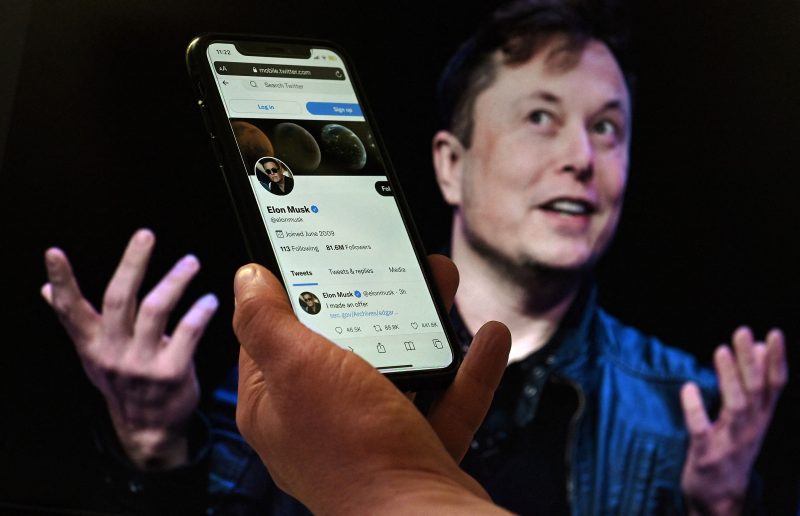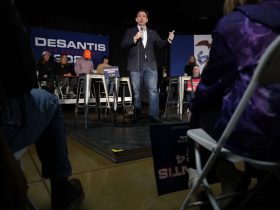I guess we can start with Donald Trump’s other big announcement on Thursday, the one that wasn’t centered on his effort to sell “digital collectibles” for $99 a pop well after the NFT bubble had burst. The collectibles announcement, centered on his interest in making money, buried the other announcement, centered on his interest in seizing political power: Trump has a proposal that he says will “shatter the left-wing censorship regime.”
In a lengthy video posted to Truth Social, Trump explains how he would use the power of the presidency to target “a sinister group of Deep State bureaucrats, Silicon Valley tyrants, left-wing activists and depraved corporate news media,” a group he says is “conspiring to manipulate and silence the American people.” To that end, he outlined a battery of potential executive actions that would, for example, ban government officials from colluding to censor Americans.
It is possible, if not likely, that you will not understand why Trump thinks this multipart proposal should be one of the first things presented by his sort-of-campaign for the Republican nomination in 2024. That is because you are not immersed in the same conversational universe as Trump and others on the right, one where the 2020 election was upended by devious government agents muffling negative information about Joe Biden by putting pressure on Twitter.
That there’s no evidence this happened is beside the point. The point is that Twitter, predictably, has become a central part of the right’s effort to undercut voices of authority outside its control. And that, also predictably, using Twitter to muffle political opponents — a horrendous scourge when people on the right thought it was happening to them six months ago — is now viewed as good. As karma.
A bit of history is useful. After the 2016 election, a new focus was placed on eradicating false information, toxic behavior and abuse from social media platforms. In 2018, Twitter announced a new policy in which users who had been identified as abusive or otherwise violating its rules would have less visibility on the site. This was quickly dubbed “shadow banning” on the right and was presented as being about politics, not behavior.
It’s impossible to adjudicate every example of limiting visibility or imposing bans to determine why the platform made the decision it did. But it is worth noting two ways in which common activity on the right might trigger violations of the rules.
First, the idea of “owning the libs” is pervasive on the right these days, an idea that often comes down to harassing those perceived as being on the left.
Second, there are issues of abuse that overlap with politics, like the treatment of trans people. What to Twitter’s management is abuse of the trans community may on the right be seen as a political statement. That a number of right-wing users were muted or banned isn’t surprising in this context — particularly once the narrative arose (promoted by Trump) that conservatives were being targeted for their politics, not their behavior.
Then there was the laptop. In the weeks before the 2020 election, Twitter blocked links to a New York Post story about a purported laptop belonging to Joe Biden’s son Hunter. The decision was quickly reversed, and there’s no indication it affected the election. But, in part because Twitter was reacting to warnings from government officials about potential foreign interference (as occurred in 2016), limiting the story has been framed as the FBI or other “Deep State” actors stepping in to try to help Biden win.
When Elon Musk took over Twitter, he passed out a bunch of internal documents to sympathetic writers who tried to build a case that the social media company had been politically biased and/or unduly influenced in its decision-making processes. Since this is what many on the right wanted to hear, those documents were hailed as proving that bias and influence, though they proved no such thing.
This is why Trump is focusing on the issue: He’s trying to claim again that the 2020 election was stolen from him and leverage right-wing anger ginned up by Musk’s release of those documents.
Over the past four years, as Twitter was under fire for purportedly trying to silence conservatives, a two-part response was offered. First, that there was no evidence that the decisions were being made to silence the right. And, second, that Twitter, as a private company, can block or limit the visibility of anyone it wants at any time. This isn’t a First Amendment issue, since Twitter is not the government.
During his tenure as owner of Twitter, Musk has waged war against the company’s former management and policies. He seems to believe the narrative about suppression of right-wing voices, which is why his initial efforts to unwind limits on users and even to restore previously banned accounts were presented as being centered on encouraging free speech. Musk insisted that free speech — free, unfiltered, unlimited speech — would be Twitter’s new watchword.
Then Ye posted a swastika. And then Musk got tired of a kid’s Twitter account tracking the movement of his personal jet. And then he got mad that people were sharing links to other ways to view the movement of his jet. And then Twitter decided to suspend the accounts of a number of reporters who were covering how Musk was handling his ownership of Twitter.
This is Twitter’s right. It’s Musk’s platform. But these actions are easily contrasted with his past professions about the sanctity of speech, not to mention his tweets about how he would welcome critics on the platform. (Musk has framed his objections to the flight information and the reporters as being about safety, though there are a number of valid questions about both an incident in which he claims his child was targeted and about the utility of flight information as a vector for committing an act of violence.)
What Musk is doing in essence is what pre-Musk Twitter did: sending a message about what sort of behavior is welcomed on the private platform. Pre-Musk Twitter decided it did not want anti-trans content, incessantly abusive users or news stories that it thought might be part of a Russian interference effort. Post-Musk Twitter doesn’t want things Musk obviously finds annoying, and it doesn’t want anti-Musk dissent. Users may make determinations about their participation on the platform based on how they feel about the sort of place Musk wants Twitter to be.
It was fascinating to watch the reaction to Musk’s decision to boot reporters who have covered him and to his imposition of the flight-information ban. Fox News, for example, celebrated that the “TABLES HAVE TURNED” in how Twitter approaches news outlets.
TABLES HAVE TURNED: Elon Musk suspends CNN, NYT, WaPo journalists, reminding them the rules also apply to them. https://t.co/DGz1u8482w pic.twitter.com/xcDOo8LBkh
— Fox News (@FoxNews) December 16, 2022
This, mind you, comes from a network that has mentioned “cancel culture” as a threat to America more than 3,000 times in the past two years. A network that spent days last year moaning about a decision from the estate of Dr. Seuss to stop publishing books containing racist imagery or language. That decision was framed by Fox not as a private decision based on consideration of obviously cringey characterizations of Black and Asian people but as “the left” going after a beloved American institution — because that’s how this works. Fox News almost never showed the actual images, because that would mean offering evidence that undercut its presentation. Just as so many on the right have preferred to talk about how pre-Musk Twitter targeted conservatives as conservatives, not as users engaged in behavior that Twitter thought degraded the service.
Nothing’s changed in terms of what Twitter can and can’t do to moderate content. What has changed is what the company wants to moderate. And what’s changed isn’t the traditional media’s view of whether moderation is allowed; it obviously is. What’s most obviously changed is how Musk and Fox and others on the right view Twitter’s ability to stifle voices it doesn’t want on its platform.
It’s still politically and culturally useful to claim that Twitter limited the reach of right-wing voices for ideological reasons. Hence Trump’s proposals. But outrage at such purported censorship has been replaced with giddiness at the muffling of the collective “left,” including traditional reporters covering Musk.
All that stuff about unfettered free speech was great as a cudgel when the right didn’t have the power. But now it does.








